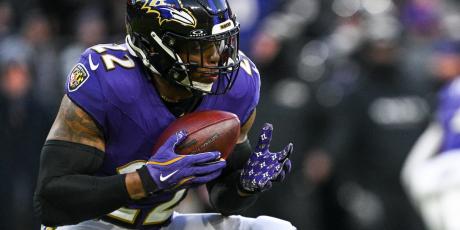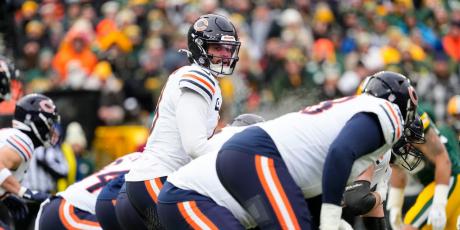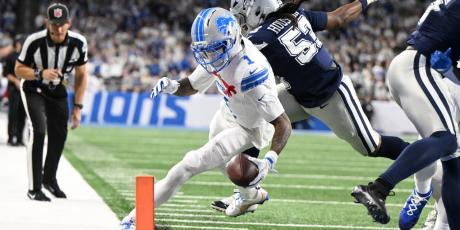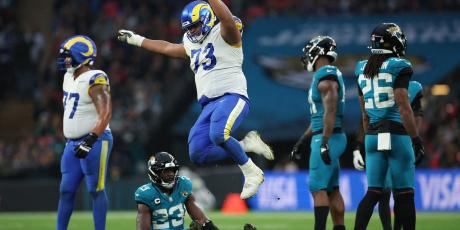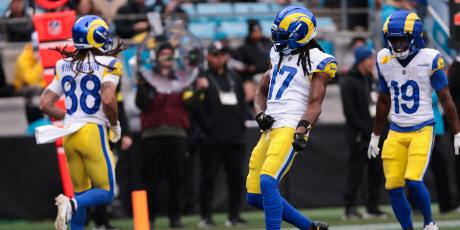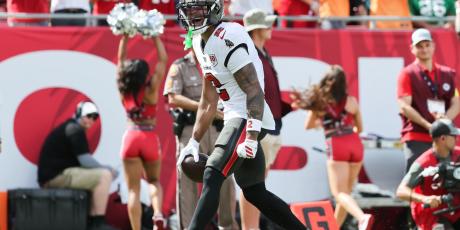How to Identify an IDP Prospect: Defensive Linemen

There’s an old Biblical adage that goes, “give a person a fish and you feed them for a day; teach them to fish and you feed them for a lifetime”. I’ve always tried to emulate this notion in my fantasy football writing. I don’t just want to explain how to approach a player and the situation that he’s in right this moment; I want to help build the skills in my readers to apply those lessons later on, without me there.
MORE IDP CONTENT: DL Rankings Breakdown | 11 Rookie DL to Target in IDP Leagues
Here’s the rub: that phrase is not a Biblical adage. It’s not an ancient Chinese proverb, or from an Italian children’s poem, nor is it a scrap of Native American wisdom. It's not even that old.
Like the dubiously assumed attestations of this saying, many people playing in Individual Defensive Player (IDP) leagues have hard ideas about what makes a great defensive fantasy prospect. Not many have more than anecdotal evidence to support their reasoning, though. That’s why I’ve gone through as many factors as possible, to see what traits or metrics will help us predict future success for IDP prospects.
First up: defensive linemen. What makes a successful defensive interior player, and how can we identify them before they play a snap in the NFL?
IDP Projection Process
When I consider prospect success in fantasy football, I typically don’t just look at rookie impact. Especially in a dynasty league, you need to consider a longer-term view of a player. The most commonly accepted evaluation window is three years, which actually matches up with the average career length for an NFL player. Beyond this point, many other factors play into player production and longevity, making projecting Year 4 onward essentially fruitless for our purposes.
Due to all this, I set my parameters for IDP production as the first three years of a player’s career. That means our 10-year sample size includes all defensive players drafted between 2009 and 2018 (the most recent class to complete its third year).
The information I collected for players includes their NFL Combine (or Pro Day) testing data and college production. I compared them to NFL games played, total fantasy points (balanced scoring system; 3 points per big play to 1 point per tackle), fantasy points per game, NFL Draft position (overall pick number), and finally college production in each category to its NFL counterpart (e.g. college tackles per game to NFL tackles per game).
The comparisons I performed use the R correlation. Essentially, this takes two related datasets and compares them to each other, quantifying them with the aforementioned R’s coefficient—a numerical value between -1 and 1. The closer to either of these the coefficient is, the stronger it is, but a value closer to 0 represents an insignificant statistical relationship. A perfect 1.00 coefficient would be represented graphically by a line rising at a 45-degree angle, showing that as one factor increases (college tackles per game, for instance), its partner also increases (NFL tackles per game) at the same rate. In data sets this large, however, coefficients tend to be on the small side, so we’re looking for the most significant ones to help us identify signposts in prospecting.
I’ll walk through the significant prospect correlations, from the strongest on down.
Draft Round/Overall Draft Slot
| Category | Value |
|---|---|
| Drafted in Round 1 | 68.0% |
| Drafted in Round 4 or Later | 8.0% |
| Average Overall Draft Value | 33.2 |
It should surprise no one that draft capital tops the charts for correlation with defensive line fantasy production over a player’s first three seasons, at -0.53 for both round and overall pick. Think of it this way: if you’re a team who just selected a J.J. Watt or Aaron Donald in the early half of the first round of the NFL Draft, you are going to justify that pick by giving that player as many snaps as they can handle. More snaps mean more chances to produce fantasy points (the same reason we look to rushing attempts or targets for offensive skill position players), so draft capital is king when evaluating prospect profiles.
What may surprise you, however, is that the relationship is just as strong between total fantasy points and fantasy points per game. Players drafted high do tend to be more talented than later picks, despite the occasional Vernon Butler or Datone Jones. Also, due to the pass-happy offensive climate of the NFL, interior defensive linemen’s draft value has been dampened unless they can be disruptive pass-rushers in addition to simply filling gaps—which will benefit you in IDP fantasy as well. This means that when we adjust for playing time, the rate stats confirm that this correlation has predictive value.
College Tackles for a Loss per Game
| Category | Values |
|---|---|
| Average NFL TFL per Game | 0.64 |
| Average College TFL per Game | 0.88 |
| Average College TFL Share | 13.9% |
I compared the early-career success categories to each of college tackles for a loss (TFL), college TFL per game, and college TFL share (the percent of team stops the player is responsible for). TFL per game gives us the strongest correlation of the three, at 0.40. This is likely due to adjusting for playing time and not rewarding prospects who had a few blow-up games but didn’t get on the field much. Interestingly, TFL totals don’t include sacks, and this has a slightly stronger relationship than the metric “Defeat Share”, which is the percentage of a team’s TFL and sacks a player earned.
Still, it makes sense that players who can get into the backfield and stop the run in college will have a dynamic enough profile to generate fantasy points in the pros. A key part of that is retaining that disruptive tendency; the R coefficient for college TFL per game and NFL TFL per game is 0.51, another incredibly strong relationship.
College Pressure Rate
| Category | Values |
|---|---|
| Average NFL Pressures per Game | 1.38 |
| Average College Pressures per Game | 0.83 |
| Average College Pressure Rate | 1.4% |
Pressure rate is the percentage of team plays where a defensive lineman generates a quarterback hurry or a sack. This metric has a relationship of 0.40 with NFL fantasy success for defensive linemen, largely for the same reasons as college TFL per game. A pressure, like a TFL, is also a disruption stat, but pressures are the product of disrupting the passing game while TFLs are the result of disrupting the run.
Another similarity between college pressure rate and college TFL per game is that both are transferrable when a defensive lineman breaks into the NFL. College sacks per game have a 0.37 R coefficient with their NFL counterpart and college hurries per game have a 0.20 correlation. We use pressure rate instead of sacks only because there are plenty of plays where a defender hassles the passer but he releases the ball a second before the sack, or another player gets there first. Pressure still gives credit to a defender who messed with the efficacy or timing of the pass attempt, and it indicates future sack success.
The Best of the Rest
Tackle share (0.34) is the one share metric that had a better correlation than its per-game or rate counterpart. The logic behind valuing tackles is that a player who is constantly around the ball has some talent that helps them get there (speed, play diagnosing, etc.), and making this a share metric helps us control for teams that played in different contexts. If two defensive linemen have 100 tackles in their college careers, but one played run-heavy competition that ground down the clock and reduced the total number of plays, those player's 100 tackles mean more than the other’s.
The one physical component that had a somewhat significant correlation was speed score, which is just the 40-yard dash time but adjusted to factor in a player’s weight. This correlation coefficient was just 0.18, however. This suggests that most physical characteristics and testing data largely don’t matter for defensive linemen, so long as they surpass basic athleticism thresholds.
2021 Rookie Standouts
Most of this research can be summed up by one final correlation: college fantasy points per game (yes, I tested this too), which has a 0.42 coefficient with NFL fantasy points for defensive linemen. Basically, if a player at interior defensive line is good in college, it’s a fair bet that they will end up being good in the pros. It doesn’t matter what shape or size they come in; the best way to find a future defensive lineman success in your IDP rookie drafts is to look for draft capital and disruptive production in college.
It’s because of those factors that my rookie projection model loves the following players.
Milton Williams, Eagles
The Philadelphia Eagles' Milton Williams blew up his Pro Day, showing out with performances in every drill that ranked in the 95th percentile among other defensive linemen in this class. The only drill he didn't ace was the bench press, where his 34 reps came in in "just" the 86th percentile. He also earned 91st percentile draft capital in this class, and his explosive disruption is highlighted by a tackle share, defeat share, and pressure rate all at 93rd percentile or higher.
Daviyon Nixon, Panthers
My model likes Carolina Panthers' fifth-rounder Daviyon Nixon second-most, despite it factoring in draft capital higher than any other component. While he didn't annihilate the Pro Day workout like Williams, he still earned a 95th percentile speed score and 80th percentile agility score. Where Nixon really shines is in his production track record: he was 93rd percentile or higher in tackle share, defeat share, and pressure rate.
Payton Turner, Saints
Payton Turner of the New Orleans Saints was a sleeper I had my eye on coming into the NFL Draft, but his first-round draft capital took away any sneaky edge I may have had there. It does confirm for us much of his prospect value as an IDP defensive lineman, though, to go along with an above-average speed score, an 84th percentile agility score, and the top reach radius in the class.
Alim McNeil, Lions
The Detroit Lions took Alim McNeill as their second defensive lineman in the draft, with their third-round pick, but my model actually likes his fantasy potential better than new teammate and second-rounder Levi Onwuzurike. McNeill posted 86th and 82nd percentile marks in speed and agility score, respectively, with 93rd percentile draft capital in this class. While he wasn't around the ball much (45th percentile tackle share), he got to it when it counted with an 84th percentile defeat share and 84th percentile pressure rate.
Christian Barmore, Patriots
Finally, Christian Barmore landed in the second round, for 98th percentile draft capital. He doesn't have eye-popping physical tools but did earn an 84th percentile speed score. Perhaps it was just a function of playing with other future stars at Alabama, but Barmore's production was a little lackluster. Still, he did pick up a 73rd percentile tackle share and 89th percentile pressure rate, so there is some upside to his game. The New England Patriots are a team that loves to let big interior players cause havoc, so Barmore could develop into something even better than his solid-not-spectacular projections indicate.
There will undoubtedly be players without the skills I highlighted that pop in the pros, but I’m just showing you how I fish. The hook is baited; now it’s your turn to cast it out and see what you can reel in.


